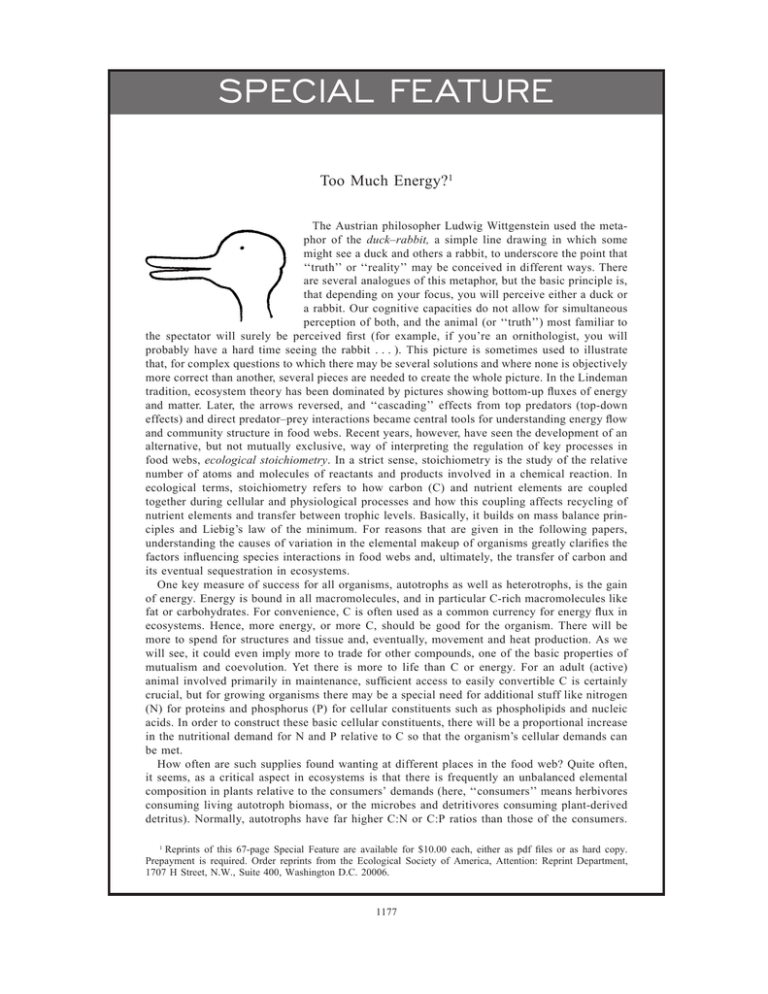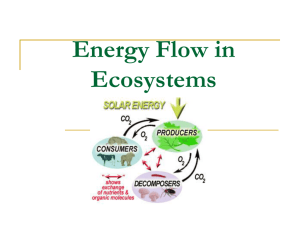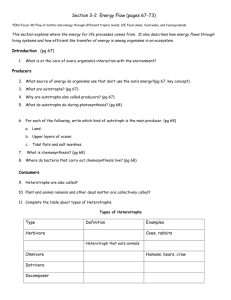SPECIAL FE AT URE Too Much Energy?
advertisement

SPECIAL FEATURE Too Much Energy?1 The Austrian philosopher Ludwig Wittgenstein used the metaphor of the duck–rabbit, a simple line drawing in which some might see a duck and others a rabbit, to underscore the point that ‘‘truth’’ or ‘‘reality’’ may be conceived in different ways. There are several analogues of this metaphor, but the basic principle is, that depending on your focus, you will perceive either a duck or a rabbit. Our cognitive capacities do not allow for simultaneous perception of both, and the animal (or ‘‘truth’’) most familiar to the spectator will surely be perceived first (for example, if you’re an ornithologist, you will probably have a hard time seeing the rabbit . . . ). This picture is sometimes used to illustrate that, for complex questions to which there may be several solutions and where none is objectively more correct than another, several pieces are needed to create the whole picture. In the Lindeman tradition, ecosystem theory has been dominated by pictures showing bottom-up fluxes of energy and matter. Later, the arrows reversed, and ‘‘cascading’’ effects from top predators (top-down effects) and direct predator–prey interactions became central tools for understanding energy flow and community structure in food webs. Recent years, however, have seen the development of an alternative, but not mutually exclusive, way of interpreting the regulation of key processes in food webs, ecological stoichiometry. In a strict sense, stoichiometry is the study of the relative number of atoms and molecules of reactants and products involved in a chemical reaction. In ecological terms, stoichiometry refers to how carbon (C) and nutrient elements are coupled together during cellular and physiological processes and how this coupling affects recycling of nutrient elements and transfer between trophic levels. Basically, it builds on mass balance principles and Liebig’s law of the minimum. For reasons that are given in the following papers, understanding the causes of variation in the elemental makeup of organisms greatly clarifies the factors influencing species interactions in food webs and, ultimately, the transfer of carbon and its eventual sequestration in ecosystems. One key measure of success for all organisms, autotrophs as well as heterotrophs, is the gain of energy. Energy is bound in all macromolecules, and in particular C-rich macromolecules like fat or carbohydrates. For convenience, C is often used as a common currency for energy flux in ecosystems. Hence, more energy, or more C, should be good for the organism. There will be more to spend for structures and tissue and, eventually, movement and heat production. As we will see, it could even imply more to trade for other compounds, one of the basic properties of mutualism and coevolution. Yet there is more to life than C or energy. For an adult (active) animal involved primarily in maintenance, sufficient access to easily convertible C is certainly crucial, but for growing organisms there may be a special need for additional stuff like nitrogen (N) for proteins and phosphorus (P) for cellular constituents such as phospholipids and nucleic acids. In order to construct these basic cellular constituents, there will be a proportional increase in the nutritional demand for N and P relative to C so that the organism’s cellular demands can be met. How often are such supplies found wanting at different places in the food web? Quite often, it seems, as a critical aspect in ecosystems is that there is frequently an unbalanced elemental composition in plants relative to the consumers’ demands (here, ‘‘consumers’’ means herbivores consuming living autotroph biomass, or the microbes and detritivores consuming plant-derived detritus). Normally, autotrophs have far higher C:N or C:P ratios than those of the consumers. 1 Reprints of this 67-page Special Feature are available for $10.00 each, either as pdf files or as hard copy. Prepayment is required. Order reprints from the Ecological Society of America, Attention: Reprint Department, 1707 H Street, N.W., Suite 400, Washington D.C. 20006. 1177 Special Feature The elemental mismatch between autotrophs and heterotrophs has to do with structural and metabolic differences. Here, another Wittgenstein duck–rabbit appears: one can say either that the consumer has insufficient nutrients or it has too much energy (C); both are correct! Excess C could be stored temporarily, but in the long run it must be disposed of. It may seem a paradox that high inputs of energy in the form of solar radiation or primary production may yield less energy flux to higher trophic levels. Yet, if a high rate of C fixation via photosynthesis is not met by a corresponding increase in uptake of N and P, autotroph biomass with low nutrient value (high C:N or C:P) will result, causing poor growth in consumers. This excess C, not utilized for herbivore growth, is likely to enter detrital feeding pathways, or it may produce heat or ‘‘energy’’ by being oxidized to CO2; if not, it will be buried as detritus in soil or sediments. Thus the balance of elements in primary production will play an important role for the overall C cycle in ecosystems. This simple idea may go a long way toward explaining the ultimate outcome of C processing in complex ecosystems. Stoichiometric analysis may also help in understanding issues related to biodiversity and community structure. For example, cellular ratios of N and P may vary substantially within species, particularly in autotrophs, but there is also important interspecific variability in all taxa and especially among heterotrophs. To some extent these variations reflect a trade-off between the need for fast growth rates (requiring large amounts of P and N for synthesis of RNA and protein) and the risk of reduced C growth efficiency due to P limitation. Thus, organisms that face a strong selection pressure for fast growth (e.g., short seasonal window for completing life cycles, increased size to avoid predators, or generally ‘‘ r-selected’’ species) could thus be expected to have different stoichiometric adaptations, or stoichiometric niches, than slow-growing, more persistent ‘‘K-selected’’ species. Might these inexorable trade-offs provide an important mechanism for differentiation and coexistence? There are other evolutionary and ecological implications that follow from the stoichiometric mismatch between autotrophs and consumers. In systems with selective grazers, the struggle for a balanced diet and nutrient elements may invoke some sort of arms race between plants and grazers. Plants (or plant tissue) of low nutritional value will not be preferred by grazers. For consumers, the challenge of deficient diet may be met by sophisticated metabolic adaptations to optimize intake and minimize losses of limiting elements—or by selecting the most appropriate food. Carnivory is certainly one way to circumvent the problems, yet for carnivores the challenge may turn into gain of sufficient energy given the general attenuation of biomass as feeding level increases. Thus, omnivory could be the more pragmatic solution. Similarly, mutualism could also arise via exchange of multiple elements. Hence stoichiometric aspects will have strong bearings for community structure and assignment of trophic position. Does food-web structure reflect the elemental needs for community members, or vice versa? These issues suggest the concept of stoichiometric niche based on each organism’s feeding preferences and growth requirements in relation to the multiple constituents (energy, N, P, Fe, etc.), and their proportions, that it requires. It is likely that stoichiometric constraints play a role in organizing both aquatic and terrestrial communities under different conditions of energy and nutrient supply. In this collection of papers we will explore how the flux and fate of carbon, from cells to ecosystems, are intimately linked with the availability, flux, and fate of other key elements like nitrogen (N) and phosphorus (P). This is but one aspect of physiology, ecology, and evolution, yet an important aspect we believe. It is certainly also a reductionistic approach, but in this Special Feature we intend to demonstrate that a holistic, system-level understanding can emerge by better incorporating a viewpoint that uses single elements as a point of departure. To paraphrase of Carl von Linneaus’ Maxima in minimis, we can sometimes perceive the greatest via the smallest. —DAG O. HESSEN Guest Editor University of Oslo Key words: holism; Liebigs’ minimum principle; mass balance; metabolism; reductionism; stoichiometry; trophic cascade. q 2004 by the Ecological Society of America






